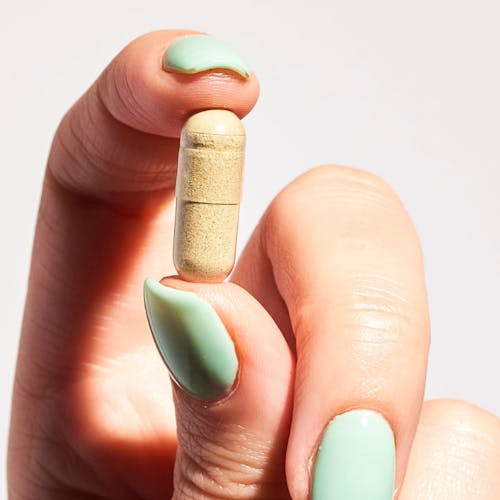This website uses cookies to enhance the user experience. By using Yoppie you are agreeing to our use of cookies.
All The Types & Stages Of Endometriosis
Written by Yoppie
25 Mar 2022
What is endometriosis?
Are there different types of endometriosis?
How do I know which type of endometriosis I have?
What are the different stages of endometriosis?
I have severe pain - does that mean I’m stage 4??
Can I stop my endometriosis from getting worse?
Endometriosis is thought to affect as many as 1 in 10 people with periods in the UK, and yet it’s still hard to diagnose. In recent years researchers have been working to further understand endometriosis, and as it turns out, there are multiple different types of endo, as well as multiple stages. We’re breaking it all down, right here…
What is endometriosis?
A quick recap; endometriosis is a disorder where tissue (similar to the kind that lines the inside of the uterus) grows outside where it’s not supposed to be - mainly around the ovaries, fallopian tubes and inside the pelvis. In rare cases, it may also grow beyond this and affect the organs inside the pelvis, such as the bowel.
When on your period, endometrial tissue inside the uterus gets thicker, breaks down and exits the body, but when this same tissue grows outside the uterus, the hormones that trigger the menstrual cycle also trigger this excess tissue. The trouble is, after it breaks down it has nowhere to go - hello pain!
Common symptoms of endometriosis include pelvic pain, painful periods, lower back pain, pain during sex, painful poos/urination, excessive bleeding, fertility issues, fatigue, and more.
Are there different types of endometriosis?
Yes! While endometriosis is still a somewhat mysterious condition, it can now be categorised into different types depending on which area of the pelvis or abdomen it affects. These are:
- Superficial peritoneal endometriosis - The peritoneum is the thin membrane lining the pelvis and abdomen, and it’s also in contact with organs in these areas. In this case, the endometrial tissue attaches to the peritoneum. Some researchers question whether surgery is the best treatment for this type of endo as it is the least severe.
- Endometriomas - When endo continues to develop over time, it can form endometriomas; dark, fluid-filled cysts affectionately named “chocolate cysts”! They come in many sizes and can grow throughout the abdomen or pelvis, but they are most often found in the ovaries.
- Deeply infiltrating endometriosis (DIE) - A scary acronym… but this type isn’t life-threatening. With deeply infiltrating endo, the tissue affects the organs in or outside the pelvis, like the ovaries, rectum, bladder and bowels. Occasionally (in 1-5% of endo cases), scar tissue sticks organs in place, known as “frozen pelvis”.
- Abdominal wall endometriosis - If tissue grows on the abdominal wall, it’s often because cells have attached to scar tissue from a surgical incision, like a C-section.
How do I know which type of endometriosis I have?
Your doctor may do some examinations such as a pelvic exam to feel for cysts, or an ultrasound to look for any endometriomas, but ultimately the best (and arguably only) way to diagnose endometriosis properly is by a procedure called a laparoscopy.
A surgeon will make a few small incisions (under general anaesthesia) to insert a tiny camera and instruments to look for signs of endo, take samples, and/or remove some of the affected tissue. This procedure can identify where your endo is, and which type you have.
What are the different stages of endometriosis?
As well as there being different types of endometriosis, there are also different stages. The American Society of Reproductive Medicine offers the most well-known scale for this, whereby doctors assign ‘points’ depending on the level of spread of endometrial tissue, the depth, and where in the body is affected. Let’s take a look at the stages…
- Stage 1 (minimal) - This is when there are just a few implants (clumps of tissue) or small lesions (affected tissue), and these could be present on the organs or the tissue lining the abdomen or pelvis. In stage 1 there is typically little to no scar tissue.
- Stage 2 (mild) - This stage means there are more implants than stage 1, and these are often found deeper in the tissue. There may also be some scar tissue present.
- Stage 3 (moderate) - Stage 3 has a lot of deep implants, and potentially a few small cysts on one or both ovaries. There could also be thick bands of scar tissue called adhesions (the kind that sticks organs together) present in stage 3.
- Stage 4 (severe) - In stage 4, there are lots of deep implants and thick adhesions, as well as large cysts on one or both ovaries. This type is the most widespread, which is why it’s often considered severe.
I have severe pain - does that mean I’m stage 4??
Not necessarily. The scale doesn’t go by pain, but rather by number of implants, lesions, adhesions and cysts present, which makes it difficult to tell which type of endo is present without a laparoscopy. The stage and type of endo you have don’t actually affect your symptoms, so someone with stage 1 endo may experience more severe pain than someone with stage 4. Confusing? Yes.
Essentially the scale exists to categorise and make treatment more effective, so just because you have mild pain doesn’t mean you can’t have stage 4 endo. The exception to this rule is fertility issues, since people with stages 3 or 4 have been found more likely to experience trouble getting pregnant than those with stages 1 or 2.
Can I stop my endometriosis from getting worse?
Unfortunately, endometriosis cannot be prevented, but there are a few ways you can manage your symptoms, such as diet and medications. Endometriosis does sometimes get better by itself, but in many cases it can further develop if not treated, so it’s best to find out the severity of your condition by seeing your doctor.
ot a question about the different types and stages of endo? Let us know so we can create more useful blog posts on the topic! You can chat to others in our Full Stop FB group, or get in touch with us directly on Instagram at @itsyoppie. Don't forget that our personalised menstrual cycle subscription box can get Endometriosis supplements, organic tampons & PMS supplements delivered easily and regularly through your letterbox, to give you just a bit more peace of mind each cycle.
Section jump
Back to top
Subscribe To Our Newsletter
YOPPIE





© 2025 Yoppie is a registered trademark of Phlo Technologies Ltd.
Yoppie's supplements are not a substitute for a varied diet and healthy lifestyle and are not intended to diagnose, treat, or cure any disease. If you are pregnant, breastfeeding, have a medical condition or are under medical supervision, please consult with your doctor before taking any of our products.







